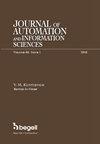DETERMINATION OF MODEL PARAMETERS OF ROCKET STABILIZATION SYSTEM IN FLIGHT
Q3 Engineering
Journal of Automation and Information Sciences
Pub Date : 2021-11-01
DOI:10.34229/1028-0979-2021-6-8
引用次数: 0
Abstract
The dynamic characteristics of the system that includes the controlled object and the regulator largely depend on the choice of the control law, which is determined based on the nominal values of the parameters of the mathematical model of the stabilization process and its priority indicator. Due to the deviation of the missile parameters and, accordingly, the model from the nominal values, the designers set the safety factors based on the most unfavorable conditions, which negatively affects the overall performance, in particular, the relative weight of the payload. Therefore, there is a need to develop algorithms for adjustment that is identification model parameters during the flight using the signals of measuring devices and the capabilities of on-board computers. This will increase the efficiency of methods of choosing the control law based on such indicators as stabilization accuracy, stability margin and power requirements of the actuator. The aim of the article is to develop methods for refining the parameters of the rocket stabilization system in the yawing plane, which are based on the use of current data of measuring devices of the part of coordinates of the state vector, and verify the effectiveness of refinement in terms of the above indicators. A linear stationary model of a system for stabilizing the perturbed motion of a rocket taking into account the inertia of the actuator in the form of ordinary fifth-order differential equations is adopted. Two approaches are proposed to approximate the model parameters to their actual values. In the first in the model parameter space there is a minimum of the integral of the distance between the points of the trajectory according to the signals of the measuring devices and the trajectory obtained by modeling the perturbation compensation process. In the second, the actual values of the parameters are the result of solving a system of nonlinear equations, which includes data from measuring devices and the corresponding data obtained by simulation. On the example of space rocket parameters it is shown that the choice of the control law based on the actual coefficients of the model leads to a significant reduction of deviations from the set value of the system stability margin, stabilization error and power of the actuator.火箭飞行稳定系统模型参数的确定
包括被控对象和调节器在内的系统的动态特性在很大程度上取决于控制律的选择,控制律是根据稳定过程的数学模型及其优先指标的参数标称值确定的。由于导弹参数和模型偏离标称值,设计人员根据最不利条件设置安全系数,这对总体性能,特别是有效载荷的相对重量产生负面影响。因此,有必要开发一种算法,在飞行过程中利用测量设备的信号和机载计算机的能力来识别模型参数。这将提高基于稳定精度、稳定裕度和执行机构功率要求等指标选择控制律方法的效率。本文的目的是利用状态矢量坐标部分测量装置的现有数据,提出在偏航平面上对火箭稳定系统参数进行细化的方法,并根据上述指标验证了细化的有效性。采用一般五阶微分方程的形式,建立了考虑作动器惯性的稳定火箭摄动系统的线性平稳模型。提出了两种逼近模型参数的方法。在第一个模型参数空间中,根据测量装置的信号与通过对摄动补偿过程建模得到的轨迹之间的距离积分存在最小值。在第二种方法中,参数的实际值是求解非线性方程组的结果,其中包括测量装置的数据和通过仿真得到的相应数据。以航天火箭参数为例,根据模型的实际系数选择控制律,可以显著减小系统稳定裕度、稳定误差和作动器功率与设定值的偏差。
本文章由计算机程序翻译,如有差异,请以英文原文为准。
求助全文
约1分钟内获得全文
求助全文
来源期刊

Journal of Automation and Information Sciences
AUTOMATION & CONTROL SYSTEMS-
自引率
0.00%
发文量
0
审稿时长
6-12 weeks
期刊介绍:
This journal contains translations of papers from the Russian-language bimonthly "Mezhdunarodnyi nauchno-tekhnicheskiy zhurnal "Problemy upravleniya i informatiki". Subjects covered include information sciences such as pattern recognition, forecasting, identification and evaluation of complex systems, information security, fault diagnosis and reliability. In addition, the journal also deals with such automation subjects as adaptive, stochastic and optimal control, control and identification under uncertainty, robotics, and applications of user-friendly computers in management of economic, industrial, biological, and medical systems. The Journal of Automation and Information Sciences will appeal to professionals in control systems, communications, computers, engineering in biology and medicine, instrumentation and measurement, and those interested in the social implications of technology.
 求助内容:
求助内容: 应助结果提醒方式:
应助结果提醒方式:


